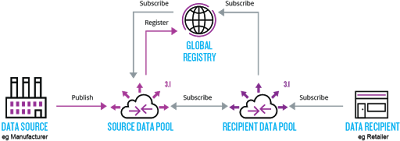How to Future-Proof Your Business Enterprise through GDSN Syndication?
The GDSN syndication simplifies,
restructures and regulates the business-critical data processing. For reaping
its full benefits, businesses should make sure data quality is at the lowest level.
In the existing hyper-connected international market, businesses require
sharing the business-critical data across the whole value web.
However, because different
businesses make use of different techniques for controlling and managing their
data, a common language is required to allow competent, consistent and harmonized
data sharing. This is achieved through GDSN syndication.
GDSN is basically a network of
interoperable information pools and a Global Registry (GS1 Global Registry),
which enables well-timed and auditable allocation of certified and identical
master data from one data source to the ultimate data receiver of this
information.
GDSN syndication standards allow
modern-age business enterprises to discover, capture, share and employ
information through making use of standards-based messages. This international
mechanism makes sure that the trading partners’ databases gets updated in sync,
thereby allowing better traceability and visibility of the product and
services.
Understanding the GDSN Syndication
Network:
In GDSN syndication, business-critical data gets
conveyed in the type of trade or catalog items. Trade items are data about every
GTIN (Global Trade Identification Number) identified products or services which
might be valued, ordered or invoiced at any level in any supply chain. Which sorts
of information gets processed through data sources, data receivers and data
pools relies on their agreed-to interaction protocols, offering enough scope
both for the data sources and data receivers. Catalog items are basically the
content of a trade item which illustrates the product or service utilization.
Catalog items are in-network data which gets stringently validated in
opposition to the GDSN standards and processed by using the GDSN standard XML
messages for making sure that the data pools make use of data in a
GDSN-compliant way. Every catalog item is exceptionally described into the GS1
Global Registry by making use of the item’s GTIN, data provider’s Global
Location Number (GLN) and the target market.
The GDSN comprises of one data source, one
source data pool, the GS1 global registry, one receiver data pool and one data receiver,
which is explained below:-
- A data source could be one product manufacturer, one distributor or one service merchant. It maintains and sends the data in any approved format the trade information which it desires to be registered into the GDSN syndication process.
- The source data pool processes the trade data forwarded through a data source authenticates it against the GDSN validation regulations and registers it like a catalog item in the GS1 Global Registry by making use of the set XML Messages.
- The GS1 Global Registry carries out item-subscription matching and facilitates consistent and compliant registration and allocation of all data across the whole network.
- The receiver data pool obtains subscriptions from a data receiver and registers it in the GS1 Global Registry. It obtains the new and updated catalog data from one source data pool and forwards it like a trade item to the data receiver.
- A data receiver is any business entity such as a medical company, retailer, distributor, customers’ group or manufacturer, which subscribes to the trade item data.
- GDSN syndication allows automatic notifications of any GDSN-verified updates about the data source’s databases. Data receivers have the freedom to acknowledge or reject the new or updated trade items.
GDSN syndication simplifies, reorganizes
and standardizes the business-critical data processing across the whole supply
chain, enabling the businesses to make sure resourceful information exchange by
their trading partners across the globe, satisfy the requirements of content-starving
customers and enhance the product and service visibility and traceability.
But for reaping full benefits of GDSN syndication,
business enterprises should make sure that the data quality start at the lowest
tier prior to it gets sent it forward for the GDSN registration and harmonization
that can only be attained through adopting a data-centric strategy to supply
chain management.






Comments
Post a Comment